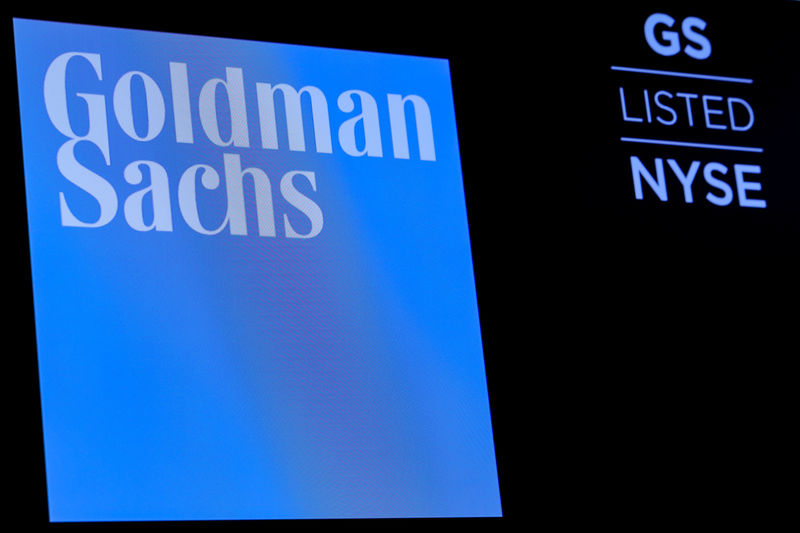By Elizabeth Dilts Marshall
NEW YORK (Reuters) - Over the past decade or so, Goldman Sachs Group Inc (NYSE:GS) has watched its annual trading profits fall 84%, as post-financial crisis regulations upended Wall Street. Now, bank executives are hoping they have figured out the key to a turnaround: asking traders to be more like investment bankers.
Over the past year, Chief Executive David Solomon and his leadership team have given the trading business a fresh mandate. They have replaced top trading executives, invested heavily in automation and turned Goldman's securities platform, called Marquee, into a product that can be sold to customers, according to interviews with six bank insiders.
Goldman plans to invest as much as $200 million in securities division technology over the next three years, a person familiar with the matter said. Much of that will go toward hiring people who know how to code.
Salespeople in the trading division, who used to primarily focus on hedge funds, are trying to make inroads with corporate treasurers, as well as portfolio managers at mutual-fund firms like Fidelity Investments and algorithmic trading houses like AQR or Two Sigma, one person said.
Trading staffers must often partner with Goldman Sachs dealmakers to forge those relationships. And, like bankers, they are now being judged by how many meetings they get and how much new business they can deliver with targeted clients, the same person said.
The changes bring a sales culture to the fore, but executives say it is not at the expense of the central risk trading approach that made Goldman traders famous.
"That core is the key to the investment-banker approach and technology investments resulting in success," another employee said.
On Tuesday, Goldman reported a 6% rise in quarterly trading revenue, benefiting from market volatility, as well as Deutsche Bank (DE:DBKGn) AG's decision to pull back from trading. But, year-to-date, the business is down 6%.
Goldman Sachs executives acknowledge that a turnaround could take years. However, they say that changes made over the past year are already making a difference, especially the efficiency savings from investments in tech.
"This quarter we saw some green shoots from the client-centric strategy we've put in place," Jim Esposito, global co-head for the securities division said in an interview.
Most major global banks have seen their trading businesses turned upside down since the 2007-2009 financial crisis. Since then, loss-stunned customers shifted product preferences and new regulations prohibited activities that had been extremely profitable or made them prohibitively expensive.
Even so, Goldman Sachs stands out among Wall Street banks because of how much its profits had been weighted in trading, and how little it changed its business model around the crisis.
Where U.S. banks like JPMorgan Chase & Co (NYSE:JPM) had big consumer and corporate lending operations, and even Goldman Sachs' closest rival, Morgan Stanley (NYSE:MS) significantly altered its business mix through an acquisition, Goldman Sachs took years to announce meaningful changes to its strategy.
In recent years, the industry of making and managing clients' trades has consolidated around the top global banks. Goldman is one of those banks, but it will need to remain "on the offensive," said Devin Ryan, an analyst at JMP Securities.
"We don't see the revenue pie expanding dramatically in legacy businesses like equity trading and (fixed income, currencies and commodities) trading," said Ryan. "There are opportunities. It's really in maintaining and gaining share as other firms retreat."
FUNDAMENTAL CHANGES
Goldman executives say these fundamental changes to the trading business will help the bank prosper over the long term.
In addition to new goals and performance metrics for trading staff, Goldman Sachs leadership has been meeting with major clients or prospective clients to find out what the bank could do better to win more business, according to two executives.
They are paying closer attention to "broker votes" that big investors submit to learn what improvements should be made to Goldman's technology, operations or customer service, executives said.
The bank has also been working to improve trading technology to lure quantitative investors.
Pricing for investment-grade credit below $2 million is now completely electronic, with plans to expand, said Adam Korn, global head of securities division "strats" and technology. Goldman used the term strats to refer to quantitative analysts.
"If you come back in a year or two, I suspect we will have automated the $2-$5 million segment of the investment grade," Korn said in an interview.
Additionally, Goldman has expanded functions of Marquee, which was once its internal trading system and opened it up to customers.
The bank is experimenting with giving clients access to proprietary data and risk analysis for a fee, possibly a monthly subscription. There are now 50,000 monthly active users of the service, Chief Financial Officer Stephen Scherr said during an earnings call on Tuesday.

"There is a great intensity and sense of urgency to measure and metric our progress with clients," Esposito said. "Trading and sales are aligned neatly around this effort."